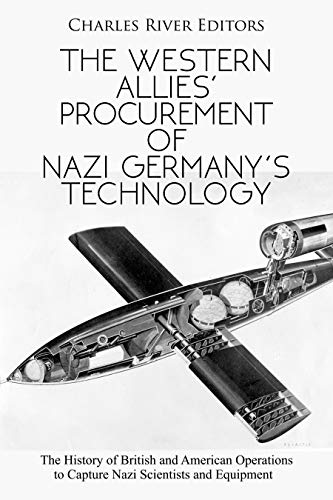The Western Allies’ Procurement of Nazi Germany’s Technology: The History of British and American Operations to Capture Nazi Scientists and Equipment
*Includes pictures*Includes a bibliography for further reading*Includes a table of contents After the last shots of World War II were fired and the process of rebuilding Germany and Europe began, the Western Allies and the Soviet Union each tried to obtain the services of the Third Reich’s leading scientists, especially those involved in rocketry, missile
*Includes pictures
*Includes a bibliography for further reading
*Includes a table of contents
After the last shots of World War II were fired and the process of rebuilding Germany and Europe began, the Western Allies and the Soviet Union each tried to obtain the services of the Third Reich’s leading scientists, especially those involved in rocketry, missile technology, and aerospace research. Naturally, this was a delicate affair due to the fact many of the German scientists were not only active Nazis but had helped the Nazi war machine terrorize the world. At the same time, by the late war period, the Anglo-American Allies formed a clear picture of the Soviet state. Though forced to ally with the USSR’s dictator, Josef Stalin, the West came to understand Communist Russia represented yet another hungry totalitarian power, and thus a very real threat to an independent Europe. British Prime Minister Winston Churchill realized the menacing character of the Soviets from the Katyn Forest Massacre of Polish army officers, if not before, while the Americans only gradually shed a naïve assumption of continued Russian friendliness after the war.
For their part, the Soviets retained ruthless imperial ambitions which manifested in various ways. They allied with Hitler for a time in 1939 to 1941, planning to divide Eastern Europe between their two expansionist states. They devastated the Ukrainian population with the Holomodor, an engineered, genocidal famine which claimed perhaps 3 million victims. The Soviet refusal to evacuate Eastern Europe following the war, instead retaining many formerly democratic countries as vassal states, spoke volumes about their intentions.
The result was the American-led “Operation Paperclip” on the Western side, which resulted in German scientists putting their expertise at the disposal of the U.S. and other NATO members. Operation Paperclip aimed not only to obtain the benefits of German scientific advances for the United States but also to deny them to the potentially hostile Soviets, as General Leslie Groves enunciated: “Heisenberg was one of the world’s leading physicists, and, at the time of the German break-up, he was worth more to us than ten divisions of Germans. Had he fallen into the Russian hands, he would have proven invaluable to them (Naimark, 1995, 207).
The Western approach, however self-interested, typically met with voluntary compliance on the German scientists’ parts. In contrast, the Soviet answer to Paperclip, Operation Osoaviakhim, used the implied threat of imprisonment, torture, and death, the characteristic tools of Stalinist Russia, to coerce assistance from German scientists and engineers following the war. These men yielded rich dividends to the Soviet state in terms of achieving at least temporary technical parity with the USSR’s western rivals.
There is an enormous amount of documentation about the American efforts, particularly Operation Paperclip and its ultimate outcomes, yet the parallel programs involving the transfer of personnel, intellectual property (IP), and equipment to the UK have attracted limited academic study and are almost forgotten by the general public. A pioneering article by John Farquharson in 1997 assessed the extent and nature of British transfers, but research into the military and civilian units that carried out the transfers had to wait until the partial declassification of official files in 2006. This was followed by the publication of sensationalist and generalized allegations of unethical practices in the mass media, which prompted personal memoirs in book form from Michael Howard (2010) and in the popular press.
The Western Allies’ Procurement of Nazi Germany’s Technology: The History of British and American Operations to Capture Nazi Scientists and Equipment analyzes the Nazis’ technological advances, and the Western Allies’ covert attempts to import Nazi scientists, technology, and resources.
Bestsellers 2021
Auto Amazon Links: No products found.







Comments
Comments are disabled for this post.